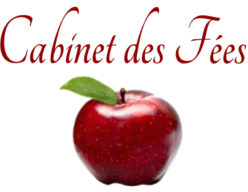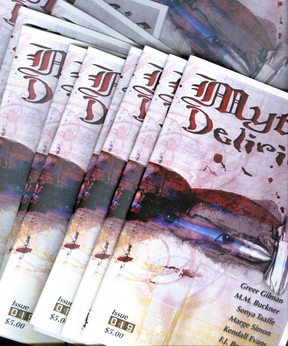 Mike Allen is a man of many projects. Here at Cabinet des Fées, we are most interested in Mythic Delirium, a journal of speculative poetry that Mike edits and publishes twice per year. No matter the genre of its collected poems, this publication (true to its name) has a decidedly mythic flavor. But this is not all Mike has given to the field, and it is not all that Mythic Delirium is. In 2006, Mythic Delirium Books was born, and MYTHIC 1 and 2, anthologies of mythic fiction and poetry, were released. In these two books, Mike’s ability to combine the poetry and prose of others into a compelling collection of fiction became even more evident, and in 2008, Clockwork Phoenix was released, another anthology in which stories were painstakingly chosen to reflect a work of surreal beauty and surprise.
Mike Allen is a man of many projects. Here at Cabinet des Fées, we are most interested in Mythic Delirium, a journal of speculative poetry that Mike edits and publishes twice per year. No matter the genre of its collected poems, this publication (true to its name) has a decidedly mythic flavor. But this is not all Mike has given to the field, and it is not all that Mythic Delirium is. In 2006, Mythic Delirium Books was born, and MYTHIC 1 and 2, anthologies of mythic fiction and poetry, were released. In these two books, Mike’s ability to combine the poetry and prose of others into a compelling collection of fiction became even more evident, and in 2008, Clockwork Phoenix was released, another anthology in which stories were painstakingly chosen to reflect a work of surreal beauty and surprise.
Mike’s own bibliography is impressive as well. His horror tale, The Button Bin is currently a Nebula finalist in the short story category and he has an impressive array of poetry to his name. A recent collection, Strange Wisdoms of the Dead, is a fine job of making the human scary and the scary human, according to the Philadelphia Inquirer. Mike is without doubt a poet, “a person possessing special powers of imagination or expression”, and he has a way of making the unreal all too real. The title of another of his collections, Disturbing Muses, probably says it all. Mike’s muses do disturb him, causing him to dig his fingers in, refusing to let go.
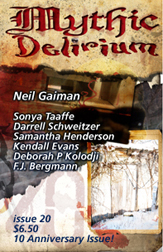 As we said, it is Mythic Delirium which interests us the most. While there has never been a comprehensive review of the 19 issues released to date, several of the issues have received mention. Amal El-Mohtar reviewed issue 13 and highly recommends it for the ease with which one can and ought to hand it over to the unenlightened and say, “You don’t like SF? Or poetry? Pfft. Read this.” Asimov’s called Issue 7 a “zoo of wonders”, and said of Issue 13 that “there’s a taste here for every lover of verse”. Luminaries such as Theodora Goss, Sonya Taaffe, Greer Gilman, Jane Yolen, Ursula K. Le Guin, Catherynne M. Valente and, with the 20th issue, Neil Gaiman grace the pages, so we should not be surprised by the quality of this “little, do-it-yourself ‘zine”. Mike is easy to talk with and very open about both his editing and writing processes, and we are very pleased that he has shared a part of his mythic journey with us.
As we said, it is Mythic Delirium which interests us the most. While there has never been a comprehensive review of the 19 issues released to date, several of the issues have received mention. Amal El-Mohtar reviewed issue 13 and highly recommends it for the ease with which one can and ought to hand it over to the unenlightened and say, “You don’t like SF? Or poetry? Pfft. Read this.” Asimov’s called Issue 7 a “zoo of wonders”, and said of Issue 13 that “there’s a taste here for every lover of verse”. Luminaries such as Theodora Goss, Sonya Taaffe, Greer Gilman, Jane Yolen, Ursula K. Le Guin, Catherynne M. Valente and, with the 20th issue, Neil Gaiman grace the pages, so we should not be surprised by the quality of this “little, do-it-yourself ‘zine”. Mike is easy to talk with and very open about both his editing and writing processes, and we are very pleased that he has shared a part of his mythic journey with us.
CdF: How did Mythic Delirium come about? What inspired you? Did you have help or has it always been a solitary venture?
Mike: Start around 1991, when I was still in college at Virginia Tech; some friends and I were talking one summer about starting a magazine ‘” that was, you know, when I was still in the frame of mind that, if I could imagine myself doing something, it had to be possible, regardless of whether I actually knew anything about the mechanics involved. I brainstormed the name “Mythic Delirium,” and even drew a logo. Nothing came of it, of course…
But then, fast forward to 1998. By then, I had sold several dozen poems and had experience with a couple of small press publishing ventures ‘” and not all of that experience had been good. I enjoyed the act of publishing but longed to start a venture wherein I only had myself to depend on and to answer to. At the time, I made my living unloading trucks for a department store, so I couldn’t possibly afford to launch a fiction magazine of decent quality; nor did I think I would have the time to read the oodles of short stories I would be in for. But poetry, I figured I could do; I had served as poetry editor for a webzine called Event Horizons ‘” not the one Ellen Datlow was part of, though they purchased the rights to the name from us ‘” and my own poetry seemed to sell fairly regularly in the small press universe.
So I fished out that old unused magazine name from college days, and I announced in Scavenger’s Newsletter, the equivalent then to what Ralan’s market listing is now. I thought at the time I could distinguish myself by limiting the content to formal poetry, which in hindsight was a mistake; though I’m still quite proud of the very first issue I put out, the restriction drastically shrunk the pool of good poems I could choose from. I also went for color covers from the very beginning as another way to try to stand out. But anyhow, I put out two issues, with much of the art crudely drawn by yours truly, and those issues were met, as far as I could tell, by complete indifference, save for a couple strange reviews that mocked my $4.50 cover price as too expensive.
Later that same year, Warren Lapine’s DNA Publications moved to nearby Radford, and Anita and I began reading submissions for their flagship publications, Absolute Magnitude and Dreams of Decadence. Given the time that took up and the failure of Mythic Delirium to gain any traction, I decided to put my pet project to sleep.
But, in the next volume of The Year’s Best Fantasy & Horror, Ellen Datlow gave honorable mentions to a couple of poems from my first issue, and more importantly, included Mythic Delirium in her list of best magazines of the year. After I told Warren about it, he asked me to revive the zine for him. And after much hand-wringing, I did ‘” so for the next five years my little project was published and paid for under the DNA umbrella. So I suppose you could say I had help ‘” quite a bit of it. I don’t know of any zine devoted to speculative poetry that’s ever had that kind of backing.
Unfortunately, as Chaucer and Nelly Fortado both said, all good things come to an end. DNA started showing multiple symptoms of taking on water, and it became clearer and clearer to me ‘” though DNA continued to cover all expenses related to Mythic Delirium, until the very last ‘” that this little passenger needed to figure out a way off the boat. Ultimately, when I said I wanted the magazine back, Warren let me take it.
Then came some serious reckoning. I had taken on all the subscription obligations up front but had no magic pot of cash to dump into the zine to cover the expenses. I should probably mention that at the time my wife was a full-time college student and our finances were under some back-breaking strain. Footing the bills for a zine seemed like the last thing I should be trying at that time. So I did the best I could to drum up new subscriptions, sell copies to online retailers like Shocklines and Clarkesworld, and also slash production costs and contributor payments (which caused some tensions of its own) without actually compromising the zine’s quality.
To make matters more alarming, a huge chunk of the subscribers I picked up in the DNA years didn’t stay with me once I was back on my own. But at the same time a number of people, subscribers and poets, did stay with me, and made it clear they were rooting for me to pull this thing off.
And lo and behold, it all balanced out. Since Issue 13, Mythic Delirium has been operating under its own power, with the landmark Issue 20 just around the corner. The zine brings in just enough money to keep itself going without me having to worry about it. As for quality, a second poem from our pages, F.J. Bergmann’s “Eating Light,” won a Rhysling Award last year ‘” I don’t really think I can ask for much more than that.
I need to give credit, too, where it’s too rarely given. Without my crew of artists, the ones who keep my zine looking like it’s something slick even though its assembly is more like a home craft project ‘” I just don’t see how Mythic Delirium could keep up the reputation it does. My not-so-secret weapon is of course Tim Mullins, who both creates the cover art and prints the covers. Years ago when I first got to know him he was producing this wonderfully decadent full color underground art zine called The Dream Engine. I asked him if he’d be willing to do some of that same stuff for me. And, though alas, Dream Engine is long dormant, Tim is still doing Mythic Delirium’s wild cover collages. Waiting to see what he’ll come up with is one of the delights of producing this zine.
But it’s not just Tim. Since Issue 11, the first issue with Le Guin, the artist lineup pretty much settled into its permanent configuration, when Paula Friedlander, who does all her illustrations using black paper cutouts, joined my pen and ink and pencil guys: Daniel Trout, Bob Snare, and the team of Don Eaves and Terrence Mollendor. Thanks to them my magazine looks like no other that’s out there. Except for maybe Paula, these folks are, in my opinion, way too shy about pitching their work to other venues. But until other editors and publishers come to their senses and lure these folks away with bigger and better gigs ‘” well, those other publications are poorer for it, and Mythic Delirium is all the richer.
CdF: The poetry in MD is certainly speculative, but would you say the content is primarily fantasy or science fiction, or do you choose from a wide variety of both? Do you see many poems that don’t fit into any particular genre? Are you aiming for a mythic flavor? I suppose what we’d like to know is, how does an issue come together for you, content-wise? And what do you hope the readers will take away from each issue, if anything?
Mike:In the early days, the content of Mythic Delirium amounted to a grab bag. I view science fiction and fantasy (and horror) as different faces of the same beast, and I edit accordingly, not really giving preference to any one thing… that said, I think that over the years, I’ve grown more experienced, and more, let’s face it, discerning in my tastes. My reading has accumulated to a point that it’s difficult to impress me if you’re showing me something I’ve seen plenty of times already. I think Mythic Delirium actually has evolved a voice, a preference for surreal (yet coherent) fusions of elements as opposed to straightforward, genre-specific “storytelling” ‘” though I’ve still got plenty of that going on too.
Looking back over my past issues, I think this voice first starts to come together as something recognizable at the end of 2002, with Issue 7; here you’ve got a strong lyrical myth-based poem by Sonya Taaffe, who was well on her way to becoming a permanent fixture in the zine’s pages, and some mind-bending cross-genre work by David C. Kopaska-Merkel and Kendall Evans, both in collobaration and solo, and a dark, surreal head-trip that’s one of my “forgotten favorites” called “Downtown Los Angeles” by a poet named Shunit Mor-Barak, whom I’ve never heard from since. So it goes with these ventures.
I never intended for Mythic Delirium to be about “myth,” but I suppose it’s true what they say about words invoking power. Maybe the best way I can describe it is this: through Sonya Taaffe, I managed to entangle myself in the startup of Jabberwocky, the eclectic poetry volumes put out by Prime Books which actively sought content based in fantasy and myth and folklore and deliberately discouraged sf content. That series drew in an entirely new set of poets who were not familiar with, say, the Science Fiction Poetry Association or the sf poetry tradition, such as it exists. When Jabberwocky filled (which as I recall happened quite fast) Mythic Delirium became the next logical target for the flood. This happened at about the same time I parted ways with DNA ‘” and I think that in the shift between the last DNA issue and the first solo issue, there’s a very discernable sea-change toward myth and mysticism, with sf poetry still present but much rarer. That’s how things have stayed since.
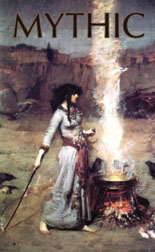 Further, I attemped to publish what was essentially my own version of Jabberwocky in 2006, a pair of books called MYTHIC. Before I edited those, I had been very conscious when accepting a poem for Mythic Delirium of whether its content fit my idea of what constituted science fiction or fantasy or what have you. (A critic once called me “the embodiment of genre” in part because of this.) But in gathering poetry for MYTHIC, I cast that code aside, or at least my strict adherence to it ‘” some of the most powerful poems in those books, such as Catherynne Valente’s “The Eight Legs of Grandmother Spider” or Gary Every’s “Sakhmet the Destroyer”, are deeply personal memoirs ‘” and it’s never returned. The poetry in Mythic Delirium now really constitutes a continuation of what I was doing in MYTHIC ‘” thus more stuff appears now that you might consider “unclassifiable.” The fiction side of MYTHIC, I suppose, has evolved into Clockwork Phoenix. I felt like I learned just enough from my own mistakes ‘” and the bad advice given to me by others ‘” in the assembling and marketing of the MYTHIC books, that I could do it over again and do it better. I pitched my idea to Vera Nazarian of Norilana Books, she was crazy enough to get behind it, and now here we are on the Locus Recommended Reading List. The second volume comes out in July, and Vera has already committed to a third.
Further, I attemped to publish what was essentially my own version of Jabberwocky in 2006, a pair of books called MYTHIC. Before I edited those, I had been very conscious when accepting a poem for Mythic Delirium of whether its content fit my idea of what constituted science fiction or fantasy or what have you. (A critic once called me “the embodiment of genre” in part because of this.) But in gathering poetry for MYTHIC, I cast that code aside, or at least my strict adherence to it ‘” some of the most powerful poems in those books, such as Catherynne Valente’s “The Eight Legs of Grandmother Spider” or Gary Every’s “Sakhmet the Destroyer”, are deeply personal memoirs ‘” and it’s never returned. The poetry in Mythic Delirium now really constitutes a continuation of what I was doing in MYTHIC ‘” thus more stuff appears now that you might consider “unclassifiable.” The fiction side of MYTHIC, I suppose, has evolved into Clockwork Phoenix. I felt like I learned just enough from my own mistakes ‘” and the bad advice given to me by others ‘” in the assembling and marketing of the MYTHIC books, that I could do it over again and do it better. I pitched my idea to Vera Nazarian of Norilana Books, she was crazy enough to get behind it, and now here we are on the Locus Recommended Reading List. The second volume comes out in July, and Vera has already committed to a third.
 But though the Clockwork Phoenix anthologies showcase fiction, even these books have poetry in their spines. One of the things Anita has done for me for Mythic Delirium for years is find emotional thematic connections among the poems I pick that allow me to arrange them in a sequence that is itself akin to an overarching poem. It’s something she has a unique talent for. We’ve been doing this for years, and though readers have occasionally noticed it, reviewers never have. But I had her do the same thing for the stories in Clockwork Phoenix, had her work with me to construct an “anthology-as-poem”… and, boy, it seems like everybody noticed it then.
But though the Clockwork Phoenix anthologies showcase fiction, even these books have poetry in their spines. One of the things Anita has done for me for Mythic Delirium for years is find emotional thematic connections among the poems I pick that allow me to arrange them in a sequence that is itself akin to an overarching poem. It’s something she has a unique talent for. We’ve been doing this for years, and though readers have occasionally noticed it, reviewers never have. But I had her do the same thing for the stories in Clockwork Phoenix, had her work with me to construct an “anthology-as-poem”… and, boy, it seems like everybody noticed it then.
But, to ratchet back to the subject at hand, despite the increased dominance of fantasy, I don’t want the sf to disappear from my pages. I mean: faster-than-light travel, time travel, galactic empires, alien conquest ‘” are these not the myths of the modern age? But I’m a bit pickier now about what I’ll use. A lot of writers who attempt “sciene fiction poetry” come up with little pieces about the wonder of going out to explore the stars ‘” sure, it’s wonderful, but after seeing the 10,000th poem on that topic, I go cross-eyed. To be fair, I have the same reaction to poems about Persephone, due to their alarming frequency.
As for actually putting an issue together, that usually involves shaking out what’s in the net and then trying to make things fit in a manner that has some artistic flow. I used to have slush parties and bring in people to help me weed through the poems, but I’ve since decided everyone’s better off if I eyeball all the poems myself. And that’s what I do. However, if I’m on the fence about a poem, I’ll always show it to Anita and ask what she thinks. My wife-as-editor system works like this: If I’m on the fence about a poem, and she likes it, I’ll take it. If she doesn’t like it and I still feel ambivalent, I reject it. But… if she doesn’t like it, and I find on reflection that I’m loathe to part with it after all, I keep it. I’ll disclose a not-so-dirty little secret: this happened with one of our best known poems, Theodora Goss’ Octavia is Lost in the Hall of Masks. That poem left Anita cold ‘” actually, a couple of my other trusted readers felt the same way ‘” but to me it seemed like Dora was doing something there that I hadn’t seen before, ever. And “Octavia” wound up becoming the first poem from our pages to win a Rhysling. Now that she’s heard Dora read the poem aloud, Anita’s changed her mind about it.
As for what readers take away from it ‘” well, I hope they’re provoked and startled and entertained; and if they are, I’d love to know. Often working in the field of speculative poetry means working in a vacuum; feedback is next to nonexistent.
CdF: And what about your own poetry? Do you see these same strands running through the work you produce? Journey to Kailash is bursting with classical references, and yet you seem to draw ideas from the future just as readily as you do from the past.
Mike: Absolutely, those threads are there. I am what I read. Mike the Writer is so co-dependent on Mike the Editor, it’s like we share the same arteries and veins somehow. Ahem.
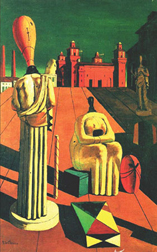 That said, I don’t have complete control over the themes that appear in my poetry. The things that I’m exposed to in life get ground into flour in the mill of my subconscious and delivered to me sometimes as dough, sometimes as a risen loaf, sometimes as flakes and crumbs. And a considerable amount of autobiographical material gets mixed in there too. There’s a dynamic in a lot of what I write in which the surface is speculative fancy but what’s directly underneath is something that might be deeply personal. “Escher’s Bed,” the second poem of the Disturbing Muses sequence ‘” written before I knew it would become a sequence -‘” is as much about my own nightly struggles with insomnia as it is about the artist’s life as it is about the myth of Procrustes.
That said, I don’t have complete control over the themes that appear in my poetry. The things that I’m exposed to in life get ground into flour in the mill of my subconscious and delivered to me sometimes as dough, sometimes as a risen loaf, sometimes as flakes and crumbs. And a considerable amount of autobiographical material gets mixed in there too. There’s a dynamic in a lot of what I write in which the surface is speculative fancy but what’s directly underneath is something that might be deeply personal. “Escher’s Bed,” the second poem of the Disturbing Muses sequence ‘” written before I knew it would become a sequence -‘” is as much about my own nightly struggles with insomnia as it is about the artist’s life as it is about the myth of Procrustes.
In that series, I constructed narrative poems about modern artists that imagined the abstract images in their paintings were objects the artists encountered in life. The poems also incorporated bits from their biographies and bits from my own fancy. I had already written three poems using that approach when I visited the Metropolitan Museum of Art in December of ’04 and induced a creative explosion. From that single prolonged burst came not only most of the Disturbing Muses series but poems like “The Psychic Above Burritoville,” which combined a childhood fascination with Tarot with images from the vast Mesoamerican art exhibit at the Met. The decisive inspiration came as I was leaving NYC and noticed a sign for a psychic above a restaurant of that same exact name.
As for classical references… well, you can’t avoid them when you tackle topics like these. For centuries, artists in Western culture who wished to paint something from the imagination other than Bible stories had only the Greeks and Romans to turn to… those myths were in essence their science fiction. So when the 20th century artists began reacting and rebelling, they too were deconstructing and rebuilding imagery from those same myths. It’s there all around them, ingrained, innate. And in inventing my own little fictions about their work, I have no choice but to acknowledge the Powers they had evoked and defied.
 And I suppose, like those artists I admire, I’m more interested in subverting and transforming than respecting. Especially when it comes to tales often retold. There’s a sort of loose trilogy of mythological science fiction poems placed toward the start of The Journey to Kailash that maybe best illustrates my method. “Tithonus on the Shore of Ocean” is my critique of D.M. Thomas’ poem “Tithonus,” filtered through an anecdote Ian Watson once shared with me about his experience with sensory depravation. “Charon Finds a Woman on the Gridshore” and “Sisyphus Walks” are both founded on stfnal ideas suggested by my friend Charles Saplak ‘” but “Charon” also bears influence from a news interview I once did with an Afghan woman about the treatment she endured under Taliban rule, while many of the images in “Sisyphus” come directly from one of my unsettling dreams. “Bacchanal,” my poem about Bacchus that follows those three in the book, blends tidbits from local and national news about the ominpresence of heroin with my reaction upon reading Allen Ginsberg’s “Howl” for the first time.
And I suppose, like those artists I admire, I’m more interested in subverting and transforming than respecting. Especially when it comes to tales often retold. There’s a sort of loose trilogy of mythological science fiction poems placed toward the start of The Journey to Kailash that maybe best illustrates my method. “Tithonus on the Shore of Ocean” is my critique of D.M. Thomas’ poem “Tithonus,” filtered through an anecdote Ian Watson once shared with me about his experience with sensory depravation. “Charon Finds a Woman on the Gridshore” and “Sisyphus Walks” are both founded on stfnal ideas suggested by my friend Charles Saplak ‘” but “Charon” also bears influence from a news interview I once did with an Afghan woman about the treatment she endured under Taliban rule, while many of the images in “Sisyphus” come directly from one of my unsettling dreams. “Bacchanal,” my poem about Bacchus that follows those three in the book, blends tidbits from local and national news about the ominpresence of heroin with my reaction upon reading Allen Ginsberg’s “Howl” for the first time.
Maybe the title poem works a bit differently. That one came about because of my fellow poet John Peery, who happened one afternoon to be talking about his new stepfather, Ganesh. On hearing this my brain immediately linked the name to the elephant-headed god of luck from Indian myth and I experienced another one of those mental explosions. And I knew for this poem to work I couldn’t take my standard creative cuisinart approach, because the narrative had to be about this family’s relationship to the new stepfather, and Ganesh needed to be, unquestionably, indisputably, recognizably Ganesh. I guess because it’s so grounded and so focused on character, I’ve had people tell me The Journey to Kailash reads like a short story. To be honest, that probably helps explain its appeal.
So maybe you can tell from this answer that I don’t have one or two overriding obsessions that guide my work. Maybe in some way this hurts me, because there are some strands, myths and folktales among them, that have pre-existing audiences hungry for retellings, and I’m not able to tap that in any kind of methodical way. My approach is a bit more scattershot. On the other hand, I think that too often poets who base their work around one theme and/or approach risk their work devolving from a style to a schtick, risk tonal consistency becoming monotony. For better or for worse, I don’t think I’m in danger of those things.
CdF: No, you certainly are not, and neither is Mythic Delirium. You are looking at the publication of your 20th issue and just announced some very exciting news. How does it feel to be publishing such stellar authors in your “little” ‘zine? You must be incredibly proud of Mythic Delirium. What does the future hold?
Mike: You bet I’m proud. I think even a small press publisher, even a do-it-yourselfer like me ‘” well, I have a duty to all my contributors and subscribers to put out a product that exhibits consistent enough quality in content, design and appearance that established pros like Neil Gaiman or Jane Yolen or Ursula K. Le Guin won’t have qualms about letting me showcase their work. As obviously they haven’t, and I’m most certainly grateful for that. I hope it’s fun for them, and it helps bring in new subscribers to check out the other writers I’m showcasing. Not to mention it brings new poets to me and to the field. I published Sonya Taaffe’s first poem, and she tried me out because she saw I’d published Jane Yolen. Now she has her own devoted following. Up and coming talent C.S. MacCath found me through Le Guin’s Website. Who knows what Neil’s appearance will kick-start?
As for the future, there’s two ways I can answer that question. First, with specifics. Obviously, our giant (by our standards) 40-page anniversary issue is just around the corner, with new poems by regulars like Sonya, Kendall Evans, Darrell Schweitzer and F.J. Bergmann. Established poets in the fiefdom of speculative poetry like Deborah P Kolodji and G.O. Clark rub elbows with newer voices like Kacey Grannis, Erin Hoffman and Holly Cooley ‘” and of course there’s Neil’s aforementioned debut in our pages, which really helps make this issue something special. I think fans of speculative poetry will enjoy his surreal and eerie contribution. And though there’s no denying he’s the headliner ‘” and how! ‘” he’s definitely not the only top notch act we’re showcasing here.
But my special plans don’t end there. The next issue, No. 21, will be a specially-themed issue centered around trickster tales. I’ve asked a prominent speculative poet to write a piece with that theme in mind, and when it’s done, I’ll be going to others, both long-time regulars and new folks, to ask them to write poems that are reactions to, reactions against, or elaborations on that first piece. My hope is to create an issue that reads like a single kaleidoscopic work, a unified whole composed of many diverse voices.
And the next issue, No. 22, involves something just as wild. I have made a pact with Jessica Wick and Amal El-Mohtar, the sickeningly talented upstarts who edit the stunning poetry webzine Goblin Fruit, to switch places for an issue. In other words, they will edit one issue of Mythic Delirium (No. 22) and I’ll at the same time take over an issue of Goblin Fruit. It should make a fun trip outside the comfort zone for all of us. And I’m pretty excited about the potential results.
After that, things will return to normal ‘” that is, if normal ever really applies.
As to the broader version of that question, I admit that from time to time I wonder how long I’m going to keep doing this. I mean: ten years? After the first year, as I said, I thought it was over.
I always have so many irons in the fire, and now some of the other things I’ve been doing, such as Clockwork Phoenix or (imagine this!) my own fiction writing have started to draw a level of attention that’s darn near impossible to get with a poetry project, even a multiple-award winning one that showcases Neil Gaiman. So I’m ashamed to admit it, but it’s sometimes, alas, easy to let my faithful little zine sit on the back burner.
And yet… and yet… the reason why I can do that is because I’ve been doing this so long that it’s almost automatic as breathing. There are so many things related to the assembling and printing of a Mythic Delirium issue that I can do without thinking… it must be one of the strangest skill sets ever possessed by a single human being. So it’s not like it’s a consuming time-eater.
And you know, quite a few more people care about Mythic Delirium than just me, as evidenced by those pesky subscription renewals ‘” a tight handful of which go back to my very first issue. I’m an entertainer myself, you know, and I love a friendly audience however I can get one. So I suppose as long as the interest remains, I’ll keep it up.
CdF: It sounds like you’ve got your work cut out for you. We can’t wait to see what results from your collaboration with Jess and Amal, but I suppose we’ll have to. In the meantime, we’ll look forward to the imminent release of Issue 20 with much glee. Congratulations to both you and Mythic Delirium for continuing to enrich the genre with brilliant and refreshing poetry. May there be many more issues of this fantastic ‘zine to come!
